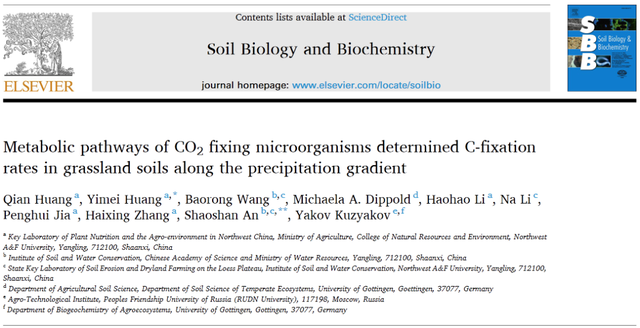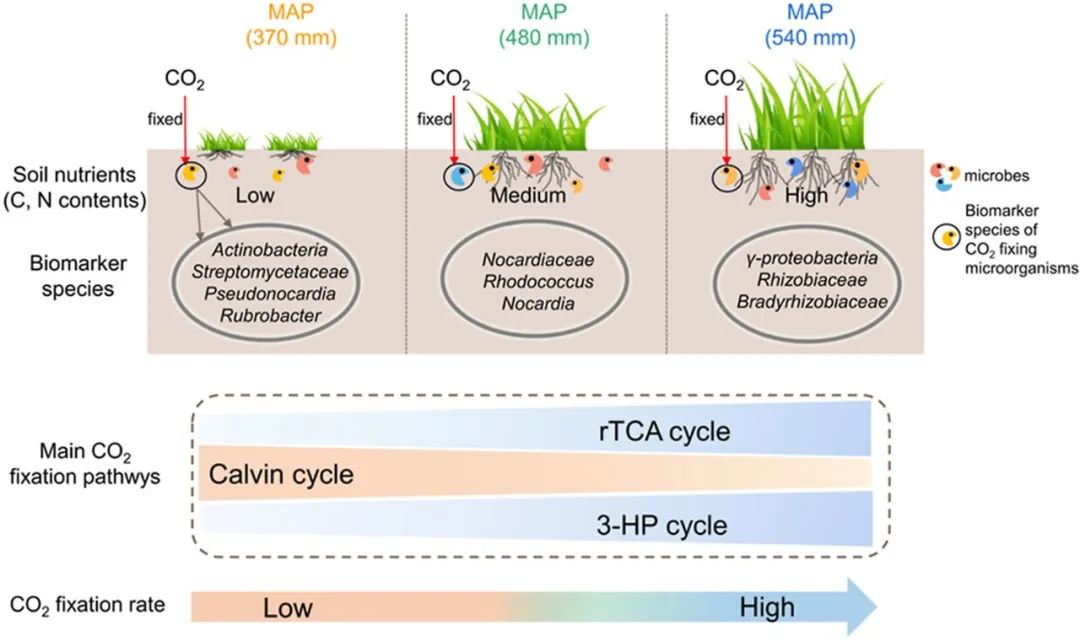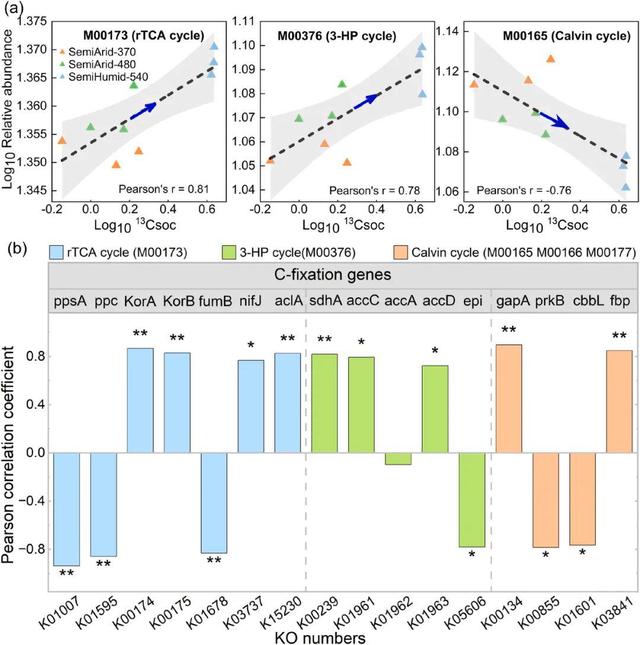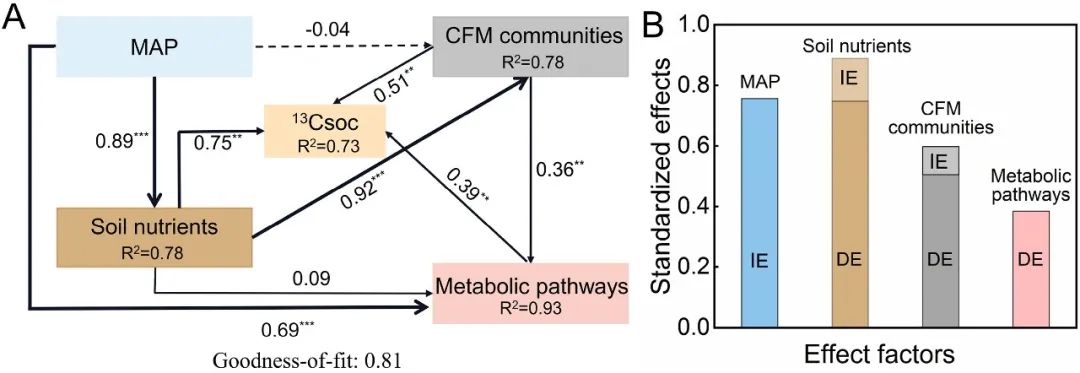
西北农林科技大学黄懿梅教授研究组以黄土高原草地生态系统为研究对象,通过13C标记、基于宏基因组学的代谢途径和微生物群落分析,揭示了固碳微生物的代谢途径决定了沿降水梯度草地土壤固碳速率的变化,阐明了土壤碳循环中微生物同化CO2增加土壤有机碳过程中的新机制。相关成果发表于土壤科学领域著名期刊Soil Biology and Biochemistry(IF=8.546)。 博士研究生黄倩为论文第一作者,黄懿梅教授和水土保持研究所安韶山研究员为共同通讯作者。该研究工作得到了国家自然科学基金(41877074和 42077072)等项目的联合资助。 阅读论文全文请点击文末阅读原文。 doi:10.1016/j.soilbio.2022.108764
CO2 fixation rates in grassland soils increased with increasing precipitation. CO2 fixing pathways in grassland soils were mainly influenced by the MAP. rTCA and 3-HP cycle dominated the CO2 fixation under the high MAP (>400 mm). Calvin was the main pathway for CO2 fixation under low MAP (<400 mm). Abstract CO2 fixing microorganisms (CFMs) play a crucial role in carbon (C) sequestration in vegetation restricted areas, e.g., under semiarid and arid conditions. The factors controlling the underlying pathways of the CO2 fixation by microorganisms living in soils remain unclear. Here, almost all genes responsible for the eight CO2 fixation pathways in semiarid soil CFMs communities were identified using metagenomicanalysis: including the reductive citrate cycle (rTCA), dicarboxylate-hydroxybutyrate cycle (DC/4-HB), reductive pentose phosphate cycle (Calvin), 3-hydroxypropionate bicycle (3-HP), 3-hydroxypropionate/4-hydroxybutyrate (3-HP/4-HB), C4-dicarboxylic acid, CAM cycle, and reductive acetyl-CoA pathway (Wood-Ljungdahl pathway). By tracing the CO2 fixation flux via 13C labeling, it was shown that the CO2 fixation rates increased along the precipitation gradient. The rTCA and 3-HP pathways for CO2 fixing microorganisms were closely associated with 13C incorporation into the soil organic matter under high mean annual precipitation (MAP) (400–600 mm), whereas the Calvin cycle played a vital role in soils under low MAP (<400 mm) conditions. The abundance of the key genes within the C fixing pathways showed that the microbial C accumulation in soils was mainly influenced by the MAP. In semi-arid to semi-humid grassland soils, where CO2 fixation by CFMs provided about 8.1–27 mg C m2 day1 input into the ecosystem, we demonstrated that the rTCA, Calvin, and 3-HP cycle were vital to this essential pathway of C sequestration.
研究表明,CO2固定速率随降水增加而增加,标志固碳类群和主要的CO2固定途径随降水梯度变化显著。在400~600 mm的年平均降水(MAP)条件下,还原柠檬酸循环(rTCA cycle)和3-羟基丙酸循环(3-HP cycle)主导微生物CO2固定过程,在< 400 mm MAP条件下,卡尔文循环(Calvin cycle)为主导(图1)。

图 1 固碳微生物固定CO2贡献于土壤有机碳的过程框架图
在MAP驱动下,CO2固定途径中的关键基因丰度变化促进了土壤微生物C积累(图2)。如参与rTCA循环、3-HP循环的KorA/B、nifJ、sdhA、accC/A/D基因的相对丰度随降水梯度的增加而增加,而与Calvin循环相关的prkB、rbcL基因丰度呈现相反趋势。这些关键基因与固碳量的关系表现出与整体途径一致的规律,表明微生物在CO2固定代谢途径中特异基因(如cbbL、KorA/B)的丰度为观察到的大气CO2固定提供了良好的证据。

图 2 优势固碳途径、碳固定基因和固碳量(13Csoc)的关系
偏最小二乘路径模型分析表明,73%的13Csoc量变化可由所选的土壤养分、群落结构和代谢途径的基因丰度解释(图3)。影响固碳微生物群落(CFMs)固定CO2的过程主要有两个:(1)年平均降水量(MAP)通过改变土壤养分影响CFMs群落组成,进而影响CO2固定;(2) MAP对与C固定相关的代谢通路的丰度有直接的正向影响。综上所述,微生物CO2固定是半干旱草地土壤C积累的重要过程,固碳微生物代谢途径决定了固碳速率的大小,研究结果为认识和评价土壤的“碳汇”功能、调控和增加土壤有机碳封存以缓解全球气候变化提供了新见解。

图 3 影响固碳微生物固定CO2的因素
责任编辑:宋潇
校对和审核:张阳 王农